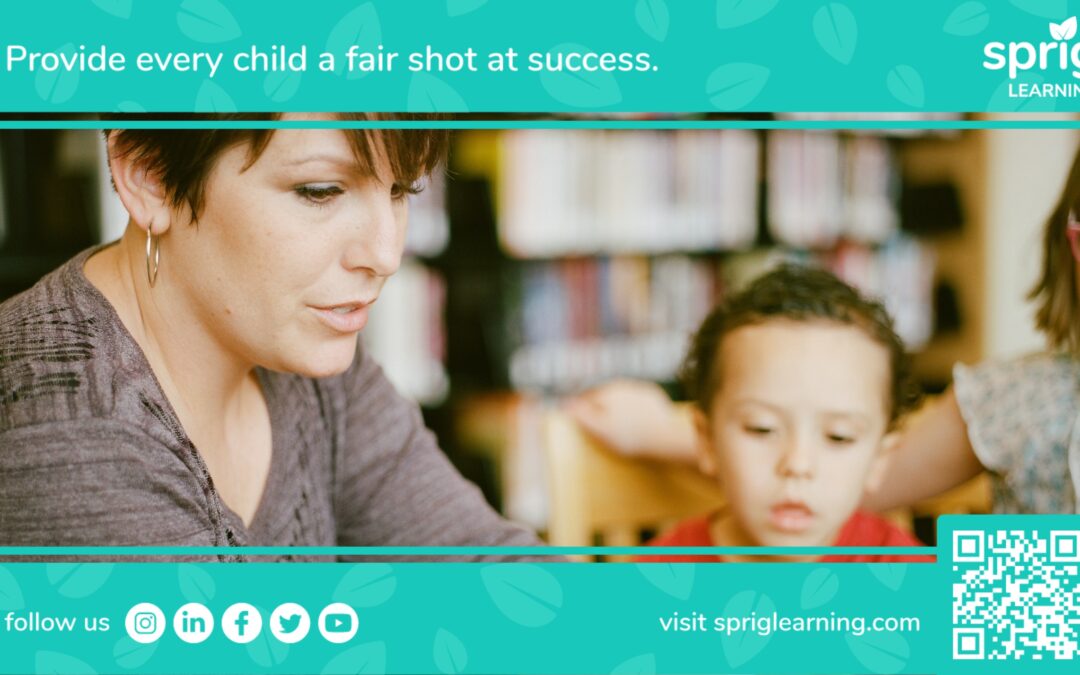During this time of post-pandemic learning recovery, school teachers and administrators are working hand in hand to improve the learning experience for students.
It’s in everyone’s best interest that students succeed! Especially when it comes to early literacy and math, proficiency in these two fundamental domains are the building blocks of success in learning and life.
Sprig Learning has worked in tandem with its education partners over the years to create early learning solutions that promote a culture of early literacy equity.
It’s a time of great change, where new approaches and resources are being tried to teach early readers, such as evidence-based reading instruction and structured literacy teaching resources.
The change process is usually preceded and followed by unfreezing and refreezing respectively. If this 2019 report from Education Week is any indication of the viewpoints held by the majority of educators, we are still at the unfreezing stage.
But the blow dealt by the pandemic to the continuity of in-school learning has definitely hastened the need to take action and speed up the change process.
The learning loss that has occurred has grabbed the attention of many school districts and teachers across North America. Some have started to implement practices that are more conducive to evidence-based early literacy.
Nine such evidence-based instruction trends are reviewed in this article, with examples. The lesson learned from each trend is discussed as well.

Trend: Aligning Professional Development with Teacher Needs for Certain Grade Configurations
At King Elementary in West Contra Costa Unified School district in Richmond, California, the school leadership team focused on aligning various professional learning spaces to help teachers improve their reading instruction.
Teachers in each grade were asked what type of professional development their grade level teams needed.
In lower grades, the focus was on phonics instruction, in middle grades the focus was on chapter books, and in the upper grades the focus was on project-based reading units.
Lesson
Before choosing professional development for the teaching staff, ask to see how it will inform their strategic reading instruction.
Trend: Obtaining Buy-in From All and Keeping Everyone on The Same Page
Schools in Pella Community School District in Pella, Iowa, use a Reading Plus Partnership pledge that is an agreement among students, parents, teachers, reading specialists and principals to reach the highest educational objectives and strive for academic success.
Parents are kept informed about all interventions. Everything is recorded to ensure accountability. Instructional procedures, materials, number of sessions, length per session, individuals involved, and follow-up notes are all recorded.
Lesson
Establishing collective ownership of literacy goals is a recommended action for increasing literacy equity, but if there is a system in place to check in on every instructional detail, it makes collaboration easier between the parties involved, including parents. Parental involvement is an established indicator of early reading success.
Trend: Creating An Atmosphere of Play-based Learning
Jess Keenan, part of the K-1 faculty, at Waynflete Academy in Maine, stresses the importance of play-based learning. Kindergartners are naturally curious and eager to learn, which lends itself well to making choices in the classroom, playing with materials, and interacting with others to learn more about the world around them via language and math.
The teacher has a responsibility to provide ample opportunities to students throughout the school day to engage with written and spoken language. In Jess’s words, “an approach to learning that is teacher-led and driven by student interest can be a powerful platform for learning.”
Lesson
Evidence-based learning is not at loggerheads with play-based learning. Both practice and play are needed, and they often complement each other. Explicit instruction needs to be practiced by students through play, where they can joyfully practice the learned concepts.
Trend: Setting Time Aside for Foundational Skills
When focusing on learning recovery, sometimes the impetus is to catch up to grade level material as soon as possible. But in the process, it is important not to gloss over the foundational skills.
Students have to be ready for the next year, but not without mastering the grade level skills first. Mastering a skill is different from merely catching up to it at the level of your peers. Knowing this, the Public schools in Milwaukee have set a standard for their teachers, where time is dedicated to focus on prerequisite skills every day.
Lesson
Each student is unique. This includes their ability to learn and retain information. If something is understood but not practiced enough times, there is a chance of forgetting it. Thus, setting aside some time to practice the fundamentals of literacy is most important.
Trend: Sustaining Small Group Instruction
Evidence suggests that tutoring in small groups is beneficial over time, regardless of the environment or circumstance the students are in. Research published in 2021 by Brown University’s Annenberg Institute for School Reform showed that consistent tutoring sessions can accelerate learning by two to 10 months.
The Bristol Tennessee City Schools (BTCS) has partnered with the Niswonger Foundation to deliver high-dosage and high-impact tutoring in literacy and math. BTCS will be reimbursed for its tutors’ and project coordinator’s salaries, as a part of this program.
Lesson
Differentiated instruction as a strategy in early literacy is widely known. When such a practice is sustained over time, the students in smaller groups reap the benefits. Whenever there is a scope of personalized learning, the class should be split into smaller groups. This will however require regular formative assessments.
Trend: Reallocating Time Blocks Based on Need
Tennessee’s Haywood County Schools (HCS) allocated a 45 minute daily intervention time slot reserved for students to work on a variety of skills, to the studying of foundational skills for all students. Reading proficiency levels in Grade 3 at HCS jumped from 8% to almost 26% within the span of a year.
Lesson
Depending on the situation, it can be helpful to consolidate various types of interventions into one lesson for the whole classroom, that is designed to master the basics, and thereby reduce the likelihood of future interventions. Again, understanding the classroom profile is key here.
Trend: Providing Intensive Instruction to Test Student’s Maximum Learning Potential
Juan, a Grade 2 student at an undisclosed elementary school, only knew half of the consonants and none of the vowels of the alphabet. Despite his assessment results reflecting that of a special needs student, he made fast progress in one school year where he moved up two reading levels. This sudden jump was a stark contrast from his prior two years of stagnation.
It was the result of an intensive phonics intervention applied by his teacher who had received dozens of hours of training in several different research-based reading programs.
Lesson
Sometimes, progress, or lack thereof, is not steady. It can happen in spurts. By not underestimating the capabilities of the student and providing intensive instruction, young learners can quickly be brought up to speed.
Trend: Aligning Intervention with Curriculum
Ethel I. Baker Elementary School in Sacramento City Unified School District has What I Need (WIN) Classes, which consists of 45 minutes of daily structured literacy intervention using a curriculum that is strong on phonological awareness, phonics and sight words.
Many students who were lagging behind have moved up one grade level throughout the course of a school year. Proficiency in listening, reading and speaking have all improved since the introduction of the program.
Lesson
Reading intervention is critical in the success of early readers. It matters if the intervention is for foundational skills, the mastering of which will form the building blocks of reading proficiency. Thus when choosing an ideal reading intervention program, it’s important to see what type of curriculum it adheres to.
Learning Lessons From Early Literacy Trends

There is a lot to learn from those teachers and staff who have taken the bull by the horn when it comes to starting early literacy initiatives. They have started to implement evidence-based early literacy practices.
It’s always good to have the right plan, but sometimes the urgency of a situation forces action before a plan.
The efficacy of school improvement plans is not universally agreed upon. According to a RAND Corporation survey, only 44% of teachers and 67% of principals believe school improvement plans change teaching practices.
In order for such plans to be effective, teachers need to be involved in the strategic planning. However, Less than half of the teachers surveyed say that strategic planning is a collaborative project in their school.
Sprig hopes that these evidence-based early literacy trends started by teaching teams at schools inspires new thinking. By looking at the results they have delivered thus far, a far broader application of these trends are warranted.

